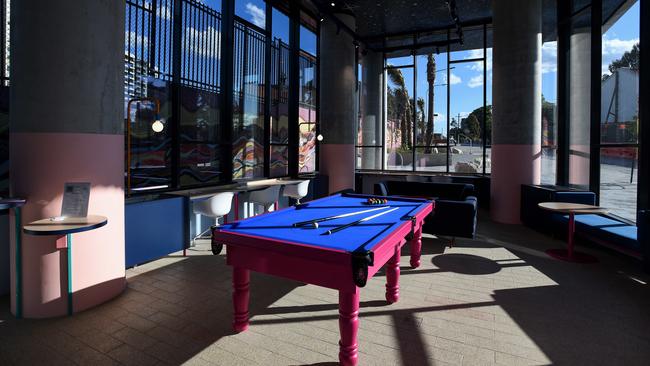Craig Carracher’s $2bn build-to-rent dream comes with a warning for others piling into the sector
His Scape empire has gone from near collapse to raising billions to break into the build-to-rent sector. But Craig Carracher doubts less savvy players entering the hot sector will thrive.

Craig Carracher has a blunt warning about the build-to-rent phenomenon sweeping Australian property.
The housing crisis is big news as rents skyrocket amid a shortage of stock and growth in demand for tenants, and governments have earmarked billions of dollars for affordable housing funds and other investment vehicles.
Big names and companies have sensed an opportunity and are piling into build-to-rent as recent tax changes make the sector look more attractive. International giants like Greystar and Brookfield and local groups including Mirvac and Gurner are among those to have announced substantial build-to-rent projects.
But Carracher says build-to-rent, where entire apartment blocks are built for renters rather than the more traditional build-to-sell to owner-occupiers or investors who then rent units out, is not the panacea for the housing crisis and the large companies getting into the sector may find it harder going than they think.
After all, Carracher should know.
He’s effectively been doing build-to-rent for the best part of a decade, after running ski fields and aquariums for the Packer family led to an fortuitous investment opportunity in a nascent part of the property industry that virtually no one else then had any interest in.

Today, the Scape business Carracher runs with business partner Stephen Gaitanos has 33 student housing projects around the country and more than 16,000 apartments in a rapidly growing portfolio.
Scape has also recently announced plans, after raising an initial $1bn from investors, for what will eventually be a $5bn empire of build-to-rent complexes constructed with the lessons learnt from thriving in student accommodation – and surviving almost going out of business during Covid.
Carracher’s ambition for his main build-to-rent fund is to have 15,000 apartments built by 2030. To show the scale of what he is doing now in student accommodation, he says he has signed 22,000 leases in the past 12 months, processing bonds and other rental procedures, and also wants to build another 10,000 “student beds” by 2030 as well.
“The government talks about wanting up to one million (dwellings) in the next five years. But if I can’t build them that quick, and I’ve got more capital than anyone else and I’ve got the operational platform and I’ve already got the deal flow – and I don’t think I can build more than 15,000 (by 2030), and I’m pretty aggressive – then I can’t see anyone building them,” Carracher warns.
“Everyone’s saying there’s about 20 to 30, maybe 40,000 of these apartments that have been identified or earmarked or capital raised for (by various developers), but that’s going to take three to four years to occur. So if the whole of the market can only deliver 30 or 40,000 apartments over the next four to five years, we’re not going to solve for the million units that are needed.”
Carracher clearly thinks upscale build-to-rent for a non-student specific population is a worthy pursuit but he is not sure that others are ready for what they are in for. In short, he says build-to-rent has unique characteristics that both developers and the wider public need to better understand.
Scape in late May announced it had raised an initial $1bn from Dutch investors APG Asset Management and Bouwinvest (who have long been investors in Scape’s student accommodation funds) for Scape’s yet-to-be-named build-to-rent platform.

That arm already is undertaking due diligence on several sites with a view to purchasing the assets for build-to-rent projects. Scape will have another fundraising close by the end of the year to take the amount it has earmarked for build-to-rent to $1.5bn.
Separately, Carracher says his business is also raising another $500m predominantly from existing investors for more student accommodation projects in a raising that will likely be finalised by September.
It means his Scape will have raised $2bn this year alone.
While Scape is joining the rush into build-to-rent, Carracher says the firm has 10 years experience doing exactly the same thing with student accommodation – experience he says sets it apart.
“It’ll take five years to educate the market, because most people have never seen a building that’s fully rented and they will be asking what it is like to live with other renters,” Carracher says.
“For us we have to think differently because we’re going to own it forever. The way we manage our buildings, we have a lot of intellectual property in the design. So for example, our buildings are designed so we can access most of the services from the hallways and not have to go into the room. We‘re not outsourcing it to a real estate agent who brings up a plumber. We do all that for our residents.”
Carracher says many of the build-to-rent projects that have already been built now have 60 to 70 per cent of their tenants as students, a figure he predicts will be cut back to 20 to 25 per cent as older renters will not want to live next to students all the time.
But he says his build-to-rent apartments will likely cater to younger people anyway, those that have left university and started working as graduates in the cities, as well as people who live on the city’s outskirts or regionally and want to have somewhere close to their CBD office to stay a few days a week.
“You might live in (Sydney’s) Palm Beach or the southern or western suburbs or Blue Mountains and say I don‘t want to do this commute daily. But I want to live in my home in the longer term and this way I have a place with flexibility that is available to me and I can leave your suits or belongings there – or it’s a great solution for a weekend concert in the city.”

Carracher himself had a mobile childhood, attending 16 different schools. His father was a salesman for technology firms and even sold the first fax machine in Australia – “it got exponentially easier to sell them after the second one,” Carracher jokes – and Carracher went on to earn a law degree at The University of Sydney.
After a stint at Oxford and a CEO role at Volleyball Australia, where Carracher remains president and is a sporting confidant of billionaire Gina Rinehart given her sponsorship of Olympic sports, Carracher worked at law firm Minter Ellison.
It was there and while working over Christmas given he had no annual leave banked, Carracher was sent to deal with Minter client and workaholic Kerry Packer. A relationship formed with the Packer family office and Carracher later worked there.
He would go on to help manage large-scale assets like the Perisher ski resort, aquariums and other real estate assets the Packer family then owned, before leaving in 2009 to co-found private equity investor Telopea Capital Partners.
Carracher went hunting for deals at Telopea with Gaitanos, considering a debt fund strategy, a couple of equity funds and private equity, before coming across an outfit called PAD student living in 2012.
They liked the “operating real estate … rather than buy/sell model” and grew the business from managing 1000 student beds to 3000 before selling to Goldman Sachs and Blue Sky Private Real Estate.
Scape had been founded by then, with Carracher noting the sheer amount of international students coming to Australia but little in the way of institutional real estate assets to house them.
“In 2014 we realised there were only two or three buildings in the country for student accommodation … and we figured that the weight of capital that was going to come to the sector was about to pour in. We just had no idea that it would come as strong and hard as it did.”
Scape would keep growing via acquisitions and be sailing along until early 2020, when Carracher got wind of a virus emerging in Wuhan, China with international students due in Australia for the new tertiary year. It would prove costly.
The business had rented 98 per cent of its units for the year, but only 75 per cent got to Australia before borders were shut. Many left by the end of 2020 and by the following year occupancy was at 15 per cent.
“We were not too big to fail. It could have happened,” Carracher says. “Our revenue was reduced by 90 per cent. We lost over those two years in total close to $500 million of revenue. We borrowed money from our equity partners. They kept the lights on by funding Scape with a shareholder loan that we are still repaying. But had Covid lasted another three or six months it may have been different.”
Scape is recovering now and Carracher and Gaitanos are pushing ahead with their dual student accommodation and build-to-rent plans.
A move into the Asia Pacific region also beckons and the pair are also looking further afield.
“We’re looking at continental Europe because we see a great need there in the student space and potentially the build-to-rent space there too,” Carracher says.
“We‘ve said we want to be the world’s best living company. It’s a bold aspiration. We call what we do ‘rent to live’ and we want people to live in our buildings because we know their best life will be lived in there.”






To join the conversation, please log in. Don't have an account? Register
Join the conversation, you are commenting as Logout